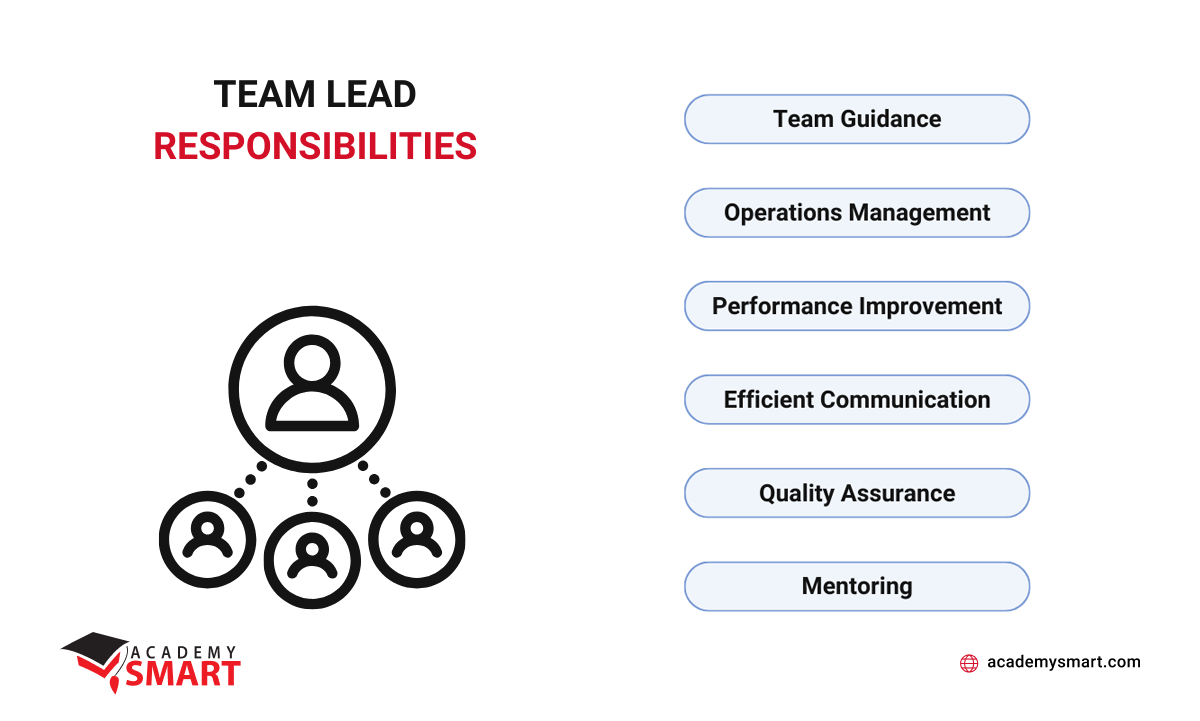
Software Development Team Lead: Roles and Responsibilities
Contents
Starting on the journey of creating their software applications, customers may encounter a multitude of specific roles and positions within the development process. Each role contributes uniquely to the project’s success, and one pivotal is that of the software development Team Lead. This position extends beyond coding, encompassing responsibilities vital to project delivery. Read on to learn more about what it is like to lead a software development team.
Who is the Team Lead in IT
In software development, team leaders are essential in guiding devs through creating application solutions. Their primary objective is to ensure the successful delivery of a software product that meets the specified acceptance criteria.
This position is often assumed by professionals who have previously held roles as developers, QA testers, product managers. At the same time, the role of a team leader is typically more focused on leadership, project management, and coordinating the efforts of a team to achieve project objectives. While technical knowledge can be beneficial and is often preferred, it is not always a strict requirement for this position. But, it’s important to note that the requirements for a team lead operations can vary between organizations’ job descriptions. Some companies prioritize technical knowledge in their team leaders, especially in highly technological or specialized IT fields.
Difference between team lead and other IT managers
It may seem that the role of a team lead is similar to a project manager, but this is often not the case. While they share similitudes, they have distinct differences in terms of their area and responsibilities:
- A team leader primarily focuses on managing a specific team within a project or department. His role is to coordinate the efforts of the team members to achieve project goals. Project managers oversee the entire project, not just a specific team. They take a holistic view of the project, from planning and initiation to execution, monitoring, and closure.
- Team leads are often responsible for the team’s day-to-day activities, including task assignment, progress monitoring, and issue resolution. They ensure that team members work cohesively and efficiently. Project managers work with multiple teams and stakeholders, ensuring that all aspects of the project align with its objectives. They manage resources, budgets, timelines, and risk at a project level. PMs identify potential risks, develop mitigation strategies, and monitor the overall project risk profile. They make high-level decisions to keep the project on track.
- Team leaders may also act as mentors, helping team members develop their skills, sharing best practices, and ensuring high-quality work output. However, their authority is typically limited to the team they lead, while they focus on managing the team’s performance and meeting project objectives. Project managers have broader authority, often extending beyond a single team. They can make strategic decisions and significantly impact the project’s success. Moreover, PMs regularly update stakeholders, report on project progress, and ensure everyone involved is informed and aligned with project goals.
To clarify the status of a software development team leader in comparison to other roles within the IT domain, let’s examine some other distinctions:
- Technical lead vs team lead
The technical lead primarily focuses on the tech aspects of software development, often with hands-on coding involvement. They guide the team on technology matters, including code reviews and design. In contrast, the team lead has a broader role encompassing project management, communication, mentoring, problem-solving, and technical understanding. - Team lead vs supervisor
A supervisor typically manages the daily activities of team members, ensuring they follow company policies and procedures. The role is more concerned with oversight and compliance. On the other hand, a team lead is more focused on project-specific goals, leadership, and achieving the desired results. - Team lead vs manager
A team lead usually leads one specific team in daily project execution. In contrast, managers often make higher-level decisions and have a broader acquaintance with business operations. - Team lead vs director
A director typically holds a senior leadership position within a company and is responsible for the strategic direction of a department or multiple departments. Directors often have much broader responsibility and decision-making authority than a team lead, who concentrates on leading a specific team to accomplish particular project objectives.
Team lead operations’ challenges
In essence, the role of team leader in software development exists to face and find solutions for most team workflow challenges:
- Communication
Effective communication with team members, stakeholders, and other teams is crucial. Team leaders must ensure that everyone is well-informed, that expectations are clear, and that information flows smoothly. - Motivation and morale
Maintaining high team morale and motivation, especially during challenging phases of a project, is essential. Team leads must inspire and support their team members to keep them engaged and productive. - Conflict resolution
Handling conflicts within the team or with other stakeholders is a crucial skill for team leaders. That includes resolving interpersonal conflicts, addressing disagreements on project priorities, and ensuring a harmonious work environment. - Meeting deadlines
Consistently meeting project timelines is a significant challenge. Team leads must manage the workload, set realistic timelines, and proactively address potential delays. - Resource constraints
Managing projects with limited resources, such as budget or staffing, is a common challenge. Controversially, while a larger team may offer advantages, such as diversified skill sets and the potential for parallelized work, it can also introduce complexities and impediments that impact the pace of development. So, a bigger team doesn’t ensure faster results in software development, either. Team leaders have to make the most of the available resources to achieve project goals. - Scope creep
In the software development industry, change is constant. Team leads must ensure that scope changes are properly documented and that their team understands and adapts to them without negatively impacting the project’s timeline and budget. - Managing remote teams
With the increasing prevalence of remote work, team leaders often manage teams distributed across different locations. Ensuring effective collaboration and communication among remote team members is a challenge. - Quality assurance
Ensuring the team delivers high-quality work involves setting and enforcing quality standards, conducting code reviews, and implementing effective testing procedures. - Skills development
To support the ongoing skill development of team members, team leaders need to identify training needs, provide learning opportunities, and mentor developers to enhance their capabilities.
Each charge requires team leaders to demonstrate various skills, including leadership, communication, problem-solving, and adaptability. Successfully addressing these challenges contributes to the overall success of software development projects, the professional growth of team members, and the delivery of perfect apps like those in our portfolio below.

Academy Smart’s projects
Team Lead Responsibilities in Software Development
We can now summarize the range of responsibilities inherent in the role of software development team leader:
- The team lead oversees a group of developers and ensures they work cohesively toward their operational objectives. It may involve assigning tasks, providing guidance, and evaluating performance. Tracking and reporting on key performance metrics to measure the dev’s progress and effectiveness is usually a part of the role.
- Team leads are often responsible for creating and executing plans for the day-to-day operations. It can involve setting goals, defining processes, and ensuring work is carried out efficiently. In addition, team leads create and maintain documentation processes, such as project events and risk logs, as needed for effective project management and reporting.
- Team leaders often work on optimizing operational processes. They identify areas where the team’s performance can be improved and implement changes to streamline workflows. It can also involve managing resources like personnel, budgets, and equipment to ensure the team can meet its project goals. Moreover, team leads coordinate with internal teams to successfully implement new initiatives and procedures seamlessly.
- Effective communication within the team and with other departments of IT management is essential. The team lead may coordinate efforts, report progress, and address issues. When operational challenges arise, the team leader is often responsible for identifying solutions and implementing them to keep processes running smoothly.
- Ensuring that the work produced by the developers meets the required quality standards is another crucial aspect of the role. That may involve setting quality benchmarks, performing quality checks, and implementing corrective measures as needed.
- Training and developing the skills and knowledge of devs may also be the responsibility of a team lead, ensuring they are well-equipped to fit their current positions.
Depending on the organization and industry, an IT team leader’s duties and requirements can vary. As you may see, team leads in software development serve as the bridge between technical execution and project management. They guide their teams, ensure quality, and maintain effective communication while contributing to the overall success of creating software products.

Responsibilities of team lead in software development
Why to Choose Academy Smart as Your IT Outstaffing Parter
Our practical experience includes creating complex web, mobile, and cloud applications for enterprise clients. Having been developing software solutions in various areas of business for more than 13 years, we have a deep knowledge of how to build the process of creating a software product as profitable and efficient as possible for our partners.
The most popular services of Academy Smart are IT staff augmentation and dedicated development teams with skilled and talented programmers, testers, designers, and project managers. Contact us for the expertise you need, and get it quickly.
Frequently Asked Questions: Role of Team Lead in Software Development
Is a team leader a manager?
Team leads are leaders but not necessarily managers in the traditional sense. While they oversee a team and provide guidance, their role often focuses more on coordinating code development efforts than managing broader organizational functions.
How to lead the team to success?
Leading a team to success involves:
- setting clear objectives;
- fostering open communication;
- empowering team members;
- providing guidance and support while adapting to changing circumstances and challenges.
Building trust and a collaborative team culture is key to achieving this aim.
Book a free consultation

Reach out to start talking today!










